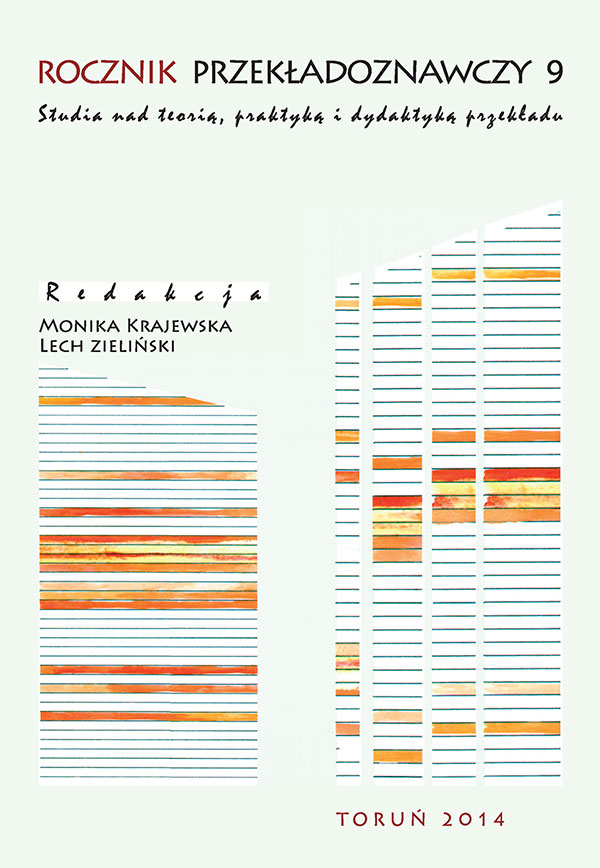Audio Description in programmes dedicated to children – a special kind of Audio Description?
DOI:
https://doi.org/10.12775/RP.2014.018Keywords
audio description, audiovisual translation, cognitive processesAbstract
The aim of this paper is to answer several very important questions concerning the role of audio description in programmes and films addressing children. By analysing the answers provided by thirty-six adults (not only blind and partially sighted but also sighted, i.e. parents of the blind children), we will try to explain why audio description in programmes and films for the blind children plays such a special role. First of all, audio description offers the blind children an opportunity to have a normal life as well as equal access to the visual media and art, and this has a great impact on the comfort of their present and future life. The blind children do not want to be discriminated against because of their disability. They do not want their visual loss to determine their life and therefore they want to share their interests with their sighted friends, watch the same cartoons and films that the sighted children watch at the time. The blind children want to be up-to-date when it comes to cartoons’ heroes and the latest film productions. That is why audio description is good for their mental condition and self-confidence. What is more, owing to audio description we can help the blind children to learn about the world, about the stereotypes that the world we live in is built upon. Clearly, it helps them to develop their own vision of the world. By using audio description, we can stimulate children’s cognitive processes as well as influence their view of the world. The results of various studies focusing on audio description for children prove that a well-prepared audio description can be fun and educational at the same time. We refer to the studies conducted by Agnieszka Szarkowska and Anna Jankowska in 2011 (Szarkowska 2011) as well as the result of the first stage of our own studies conducted in 2013 on the artistic audio description (Zabrocka 2014a and 2014b) and children’s preferences concerning the voices that read the audio description script. It improves the blind children’s language skills and develops their vocabulary (Zabrocka, the aforementioned results were presented in September 2013 in Dubrovnik during the 5th Conference Media for All). Audio description helps the blind children to learn normal life and that is why its role seems to be so crucial and unique; this was emphasised by the participants of the study described in the paper.
References
Braun, S., 2007, Audio Description from a discourse perspective: a socially relevant framework for research and training, http://epubs.surrey.ac.uk/303024/1/fulltext.pdf (dostęp: 15 grudnia 2013 r.).
Giełzak-Chudziak, M., 2010, „Miejsce środków masowego przekazu w czasie wolnym dzieci”, [w:] Edukacja, wychowanie, poradnictwo w mediach, M. Wawrzyniak-Chodaczek, A. Łysak, M. Kondracka-Szala (red.), Toruń, s. 38–57.
Fels, D.I., Udo, J.P., Diamond, J.E., Diamond J.I., 2006, „A Comparison of Alternative Narrative Approaches to Video Description for Animated Comedy”, [w:] Journal of Visual Impairment and Blindness, nr 100(5), s. 295–305.
Krejtz, I., Szarkowska, A., Walczak, A., Krejtz, K., Duchowski, A., 2012a, „Audio Description as an Aural Guide of Children’s Visual Attention: Evidence from an Eye-Tracking Study”, [w:] ETRA’12 Proceedings of the Symposium on Eye Tracking Research and Applications, New York, s. 99–106.
Krejtz, K., Krejtz, I., Duchowski, A., Szarkowska, A., Walczak, A., 2012b, „Multimodal learning with audio description: an eye tracking study of children’s gaze during a visual recognition task”, [w:] Proceedings of the ACM Symposium on Applied Perception (SAP ’12), New York, s. 83–90.
Malzer-Semlinger, N., 2012, „Narration or description: What should audio description ≪look≫ like?”, [w:] Emerging topics in translation: Audio description, E. Perego (red.), Triest, s. 29–36.
Orero, P., 2011, „Audio description for children: Once upon a time there was a different audio description for characters”, [w:] Entre texto y receptor: Accesibilidad, doblaje y traduccion, E. Di Giovanni (red.), Frankfurt, s. 169–184.
Orero, P., 2012, „Film reading for writing audio descriptions: A word is worth a thousand images?”, [w:] Emerging topics in translation: Audio description, E. Perego (red.), Triest, s. 13–28.
Osolińska, T., 2010, „Wpływ mediów na zadawanie pytań przez dzieci w wieku przedszkolnym”, [w:] Edukacja, wychowanie, poradnictwo w mediach, M. Wawrzyniak-Chodaczek, A. Łysak, M. Kondracka-Szala (red.), Toruń, s. 13–22.
Remael, A., Vercauteren, G., 2007, „Audio describing the exposition phase of films. Teaching students what to choose”, [w:] Trans. Revista de traductologia, nr 11, s. 73–93.
Schmeidler, E., Kirchner, C., 2001, „Adding audio-description: does it make a diference?”, [w:] Journal of Visual Impairment and Blindness, nr 95(4), s. 197–212.
Snyder, J., 2005, Audio Description: The visual made verbal, http://www.audiodescribe. com/links/AD-The%20Visual%20Made%20Verbal.pdf (dostęp: 15 grudnia 2013 r.).
Szarkowska, A., 2011, Audiodeskrypcja z syntezą mowy, http://avt.ils.uw.edu. pl/ad-tts/ (dostęp: 15 grudnia 2013 r.).
Szymańska, B., 2011, „Audiodeskrypcja, czyli o tym jak kultura audiowizualna staje się dostępna dla osób niewidomych”, [w:] Tyflo Świat, nr 4 (13), s. 26–37, http://www.firr.org.pl/uploads/PUB/tyfloswiat_4_13_2011.pdf (dostęp: 15 grudnia 2013 r.).
Szymańska, B., Rekomendacje dotyczące udostępniania instytucji muzealnych osobom z niepełnosprawnością wzroku i tworzenia audiodeskrypcji do dzieł plastycznych, http://www.nimoz.pl/pl/dzialalnosc/edukacja/audiodeksrypcja- i-inne-metody-udostepniania-zbiorow-muzealnych-oso bom-z-niepelnosprawnoscia-wzroku (dostęp: 15 grudnia 2013 r.).
Tomaszkiewicz, T., 2008, Przekład audiowizualny, Warszawa.
Walter, N., 2007, Nowe media dla niewidomych i słabowidzących, Poznań.
Zabrocka, M., 2014a, „Audiodeskrypcja artystyczna w odbiorze osób niewidomych i niedowidzących”, [w:] Języki specjalistyczne wczoraj, dziś i jutro, M. Łukasik, B. Mikołajewska (red.), Warszawa, s. 454–466.
Zabrocka, M., 2014b, „Audiodeskrypcja tradycyjna a audiodeskrypcja artystyczna: o wpływie języka i formy audiodeskrypcji na komfort jej odbioru przez osoby niewidome i niedowidzące”, [w:] Słowo we współczesnych dyskursach, K. Jachimowska, B. Kudra, E. Szkudlarek-Śmiechowicz (red.), Łódź 2014, s. 453–462.
Downloads
Published
Issue
Section
Stats
Number of views and downloads: 835
Number of citations: 0



